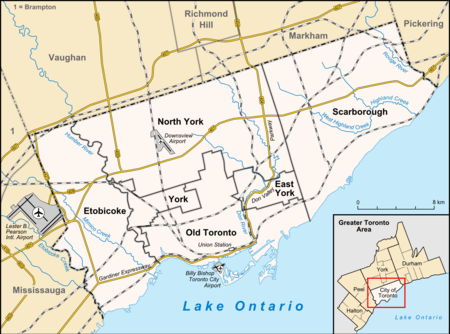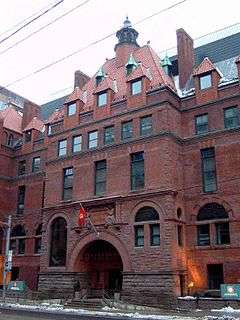The Hospital for Sick Children (Toronto)
The Hospital for Sick Children, corporately branded as SickKids, is a major pediatric teaching hospital located on University Avenue in Toronto, Ontario, Canada. It is affiliated with the Faculty of Medicine of the University of Toronto.
| The Hospital for Sick Children | |
|---|---|
 | |
 The Hospital for Sick Children from University Avenue | |
%26groups%3D_33dc004cab01a94a9ac426004c54c0b8bfd01832.svg)
| |
 Location in Toronto | |
| Geography | |
| Location | 555 University Avenue Toronto, Ontario, Canada M5G 1X8 |
| Coordinates | 43.6571°N 79.3885°W |
| Organisation | |
| Care system | Medicare |
| Funding | Public hospital |
| Type | Specialist |
| Affiliated university | University of Toronto Faculty of Medicine |
| Services | |
| Emergency department | Pediatric Level 1 Trauma Centre (Tertiary) |
| Beds | 453 |
| Speciality | Children's Hospital |
| Helipad | TC LID: CNW8 |
| History | |
| Opened | 1875 |
| Links | |
| Website | www |
The hospital's Peter Gilgan Centre for Research and Learning is believed to be the largest pediatric research tower in the world at 69,677.28 square metres.[1] Founded in 1875, the hospital was inspired by the example of Great Ormond Street Hospital in London.
The hospital is located in the Discovery District of Downtown Toronto on University Avenue, adjacent to the Toronto General Hospital and across from Mount Sinai Hospital and the Princess Margaret Cancer Centre—collectively forming a complex known as Hospital Row, each connected by tunnels and bridges. The hospital is known for its advertisement campaigns and the largest amounts of donations received for any Canadian hospital.
History



During the spring of 1875, an eleven-room house was rented for $320 a year by a Toronto women's bible study group led by Elizabeth McMaster.[2] They set up six iron cots and "declared open a hospital 'for the admission and treatment of all sick children.'" Their first patient, a scalding victim named Maggie, came in on April 3. Forty-four patients were admitted to the Hospital in its first year of operation and sixty-seven others were treated in outpatient clinics.[3]
In 1876 the hospital moved to larger facilities. In 1891 the hospital moved from rented premises to a building constructed for it at College and Elizabeth streets where it would remain for sixty years. This old building, known as the Victoria Hospital for Sick Children, is now the Toronto area headquarters of Canadian Blood Services. In 1951 the hospital moved to its present University Avenue location, on the grounds where Canadian-born movie star Mary Pickford's childhood home once stood.[3]
In 1972,[4] the hospital was equipped with a rooftop helipad (CNW8).[5] Today, it is one of two downtown Toronto hospitals with a helipad (the other being St. Michael's Hospital) and one of three in Toronto (the third being at Sunnybrook Hospital).
SickKids Hospital underwent a major expansion in 1993 with the construction of a glass-roofed atrium on the east side of the main building. In late 2008, the hospital underwent a major renovation in the emergency wing.
Funding
.jpg)
Medical treatments at the hospital are covered by publicly funded health insurance, as is the case in most other Canadian hospitals. Philanthropy is a critical source of funding for SickKids Hospital that is separate and distinct from government and granting agencies. In 2006/07, financial support from SickKids Foundation to the hospital totalled $72.1 million. The support went towards infrastructure and support for physicians, researchers and scientists who compete for national and international research grants. Next to government, SickKids Foundation is the largest funding agency in child health research, education and care in Canada. The Foundation maintains a fund, called the Herbie Fund, for patients not covered by Canadian health insurance. The fund was established in 1979 to provide for the treatment of Herbie Quiñones, a seven-month-old patient from Brooklyn, New York.
Contributions to medicine
The hospital was an early leader in the fields of food safety and nutrition. In 1908 a pasteurization facility for milk was established at the hospital, the first in Toronto, and 30 years before milk pasteurization became mandatory.[6] Researchers at the hospital invented the infant cereal, Pablum. The research that led to the discovery of insulin took place nearby at the University of Toronto and was soon applied at the hospital. Doctor Frederick Banting, one of the researchers, had served his internship at SickKids Hospital and went on to become an attending physician there. In 1963 William Thornton Mustard developed the Mustard surgical procedure used to help correct heart problems in blue baby syndrome.[6] In 1989, a team of researchers at the hospital discovered the gene responsible for cystic fibrosis.[7]
Controversy
The hospital housed the Motherisk Drug Testing Laboratory.[8] At the request of various child protection agencies 16,000 hair samples were tested from 2005 to 2015. Former Ontario Appeal Court judge Susan Lang reviewed Motherisk Drug Testing Laboratory and determined that they were not qualified to do forensic testing. Susan Lang also stated "That SickKids failed to exercise meaningful oversight over MDTL's work must be considered in the context of the hospital's experience with Dr. Charles Smith".[9] The 2008 Goudge Report found Dr. Charles Smith, whose forensic testimony led to wrongful convictions in the deaths of children, was also not qualified to do forensic testing.[10]
References
- Braithwaite, Max (1974). Sick Kids: the story of the Hospital for Sick Children in Toronto. Toronto: McClelland and Stewart. ISBN 0-7710-1636-0.
- Wright, David (2016). SickKids: The History of the Hospital for Sick Children. Toronto: University of Toronto Press. ISBN 978-1442647237.
Footnotes
- Mariana Ionova (August 26, 2013), "Sick Kids honours donor Peter Gilgan for $40 million donation", The Toronto Star
- Dueck, Lorna (2016-03-16). "Doctor-assisted dying: Why religious conscience must be part of the debate". The Globe and Mail.
- "SickKids History". Hospital for Sick Children. 2005-12-15. Archived from the original on 2006-09-08. Retrieved 2006-09-14.
- "Opened first hospital rooftop heliport for emergency transfer of patients (1972)". Hospital for Sick Children. Retrieved 2013-06-08.
- Canada Flight Supplement. Effective 0901Z 30 January 2020 to 0901Z 26 March 2020.
- Hospital - About SickKids - History and milestones - Milestones - 1951–1975, accessed 12 June 2015.
- Hospital - About SickKids - History and milestones - Milestones - 1976–2000, accessed 20 June 2015
- Lang, Hon. Susan E. (December 15, 2015). "Report of the Motherisk Hair Analysis Independent Review" (PDF). Ontario Ministry of the Attorney General. Toronto, Ontariio. Retrieved August 26, 2019.
- Charles, Ron (February 8, 2016). "Motherisk scandal highlights risk of deferring to experts without questioning credentials". CBC News. Retrieved August 26, 2019.
- Goudge, Stephen T. (September 30, 2008). "Inquiry into Pediatric Forensic Pathology in Ontario" (PDF). Attourney General of Ontario. ISBN 978-1-4249-7794-9. Retrieved August 26, 2019.
External links
| Wikimedia Commons has media related to Hospital for Sick Children. |